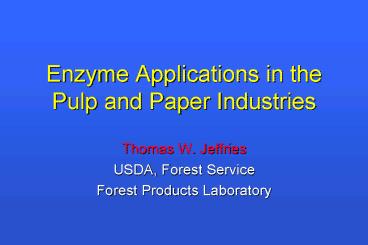Enzyme Applications in the Pulp and Paper Industries - PowerPoint PPT Presentation
1 / 21
Title:
Enzyme Applications in the Pulp and Paper Industries
Description:
Per capita consumption of paper in the United States exceeds 300 ... Alkenyl succinic anhydride. Alkyl ketone dimer. Added to paper to prevent ink from running ... – PowerPoint PPT presentation
Number of Views:4881
Avg rating:3.0/5.0
Title: Enzyme Applications in the Pulp and Paper Industries
1
Enzyme Applications in the Pulp and Paper
Industries
- Thomas W. Jeffries
- USDA, Forest Service
- Forest Products Laboratory
2
Pulp and paper processing is one of the largest
uses of biomass today
- Per capita consumption of paper in the United
States exceeds 300 kg annually. - Paper consumption increases with standard of
living. - Established processes are inefficient and
environmentally costly. - Greater emphasis is being placed on fiber recycle.
3
Biotechnology will affect pulp and paper
processing in increasing ways.
- Enhanced bleaching of chemical pulps
- Better removal of ink from recycled fibers
- Disposal of cellulosic fines
- Improved processing of mechanical pulps
- Bioremediation of waste streams
4
Enhanced bleaching by xylanases and mannanases is
becoming commercial.
- Discovering effective enzymes
- Thermostable
- Alkaline active
- High turnover number
- Cloning and producing them in high yield
- Understanding process conditions for application
5
Xylanase treatment economically reduces chlorine
demand in bleaching
- Chlorine bleaching costs about 15 to 18 per
ton. - Enzyme treatment reduces chlorine by 30 to 50.
- Xylanase treatment of hardwood pulp costs about
6 to 10 per ton. - Other bleaching technologies are more expensive.
6
Enzymatic deinking could become commercial.
- Deinking is critical in fiber recycle.
- Residual ink decreases brightness.
- Toner particles create a conspicuous background.
- Toners and inks are hard to separate from fibers.
- Microbial cellulases facilitate contaminant
removal.
7
Enzymes might have roles in other pulp and paper
processes.
- Retting
- Bark removal
- Pitch removal
- Lignin removal
- Enhanced fiber bonding
- Inter-fiber bond strength restoration
8
Microbial xylanases for enhanced bleaching of
chemical pulps
- First demonstrated by Liisa Viikari in 1985
- Showed that xylanases rather than lignanases
could reduce chlorine demand - Some xylanases are more effective than others
- Commercial products show high thermal stability
and alkaline activity - Mechanism is still not completely understood
9
Xylanases enhance bleaching chemical
accessibility and remove chromophores
- Xylan is solubilized during the pulping process
- As the pH drops, xylan is deposited on fiber
surfaces - Precipitated xylan blocks extraction of lignin
- Xylan facilitates inter-fiber bonding
- Chromophores in pulp are cross linked to xylan
- Xylanases can release chromophores from fibers
10
Conclusions
- Xylanases reduce chemical bleaching
- Thermo-stable, alkaline-active enzymes are
commercially available - Enzymes increase pulp accessibility and
chromophore release - Xylanases act synergistically
11
Microbial cellulases can enhance deinking and
toner removal
- Deinking and contaminant removal are major
barriers in paper recycling - Toners are particularly difficult to remove
- Resilient plastic polymers
- fused to the fibers
- Cellulases release toners from fiber surfaces
- Cellulases increase drainage rates
12
Enzyme action is affected by paper constituents
and deinking conditions
- Mechanical vs. chemical fibers
- Presence or absence of sizing agents
- Consistency of deinking
- pH of pulp
13
Enzyme action is affected by paper constituents
and deinking conditions
- Chemically-pulped fibers are more susceptible
than mechanically-pulped - Sizing agents reduce enzyme activity
- Enzyme action is complemented by maceration
- Many recycled fibers have an alkaline pH due to
carbonate loading
14
Fungal cellulases work well with acid sized or
mechanical papers
- Low doses of enzymes release toners
- Higher treatments effective for dispersible inks
- Excess enzyme and mechanical action reduces the
deinking effect - Xylanases have little effect
15
Sizings reduce the effect of enzymes
- ASA and AKD
- Alkenyl succinic anhydride
- Alkyl ketone dimer
- Added to paper to prevent ink from running
- Increase hydrophobic character of fiber
- Interfere with enzyme action
- Can be overcome by the addition of surfactants
16
Laser and xerographic toners are among the most
difficult to remove
- Nylon based polymers
- Particles do not readily disperse
- Fused to the fiber surface
- Have similar density as fibers
- Dispersible inks used in newsprint and magazines
17
Pilot plant deinking trials have been promising
- Novozyme 342 (Humicola insolens)
- Neutral-active fungal cellulase complex
- Three runs of 2,300 kg each
- 100 toner office waste paper
- Control heat inactivated enzyme
- Enzyme run 1 Ambient pH, 0.4 L/1000 kg
- Enzyme run 2 Adjusted pH to 7.9
18
Enzyme treatment conditions
- Fiberize for 5 min at 16 consistency with 0.125
surfactant - Add enzyme batchwise in 10-15 of pulp volume
- Pulp at 14 consistency with enzymes
- 50C, 30 min
19
Conclusions
- Cellulases can remove toners from fibers
- Pulp pH must be in enzyme activity range
- Surfactants overcome presence of sizings
- Mechanical action is a critical variable
20
Enzymatic bleaching
- Marguerite Sykes
- Tony Grabski
- Rajesh Patel
- Vina Yang
- Graziano Elegir
- Zenghui Zhuang
21
Enzymatic deinking
- Marguerite Sykes
- Kathie Cropsey
- John Klungness
- Vina Yang































